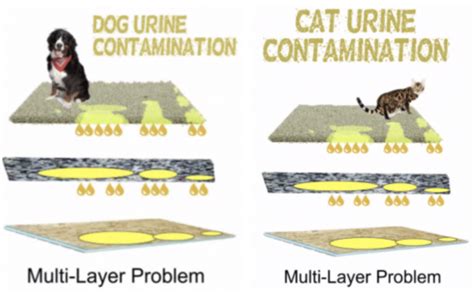Pet odor and stains can be a major nuisance, but they can also pose serious health risks to you and your family.

1. What are the health risks of pet odor?
Pet odor is caused by bacteria that break down organic matter in pet urine and feces. These bacteria can produce a variety of harmful chemicals, including ammonia, hydrogen sulfide, and methane. Exposure to these chemicals can cause a range of health problems, including:
- Respiratory problems
- Eye irritation
- Skin irritation
- Headaches
- Nausea
- Dizziness
In some cases, exposure to pet odor can even lead to serious health problems, such as asthma and bronchitis.
2. What are the health risks of pet stains?
Pet stains can also pose health risks, especially if they are not cleaned up promptly. Stains can contain bacteria that can cause infections, such as:
- Staphylococcus aureus
- Escherichia coli
- Salmonella
These bacteria can be spread to humans through contact with contaminated surfaces or objects. Infection can cause a variety of symptoms, including:
- Skin infections
- Respiratory infections
- Gastrointestinal infections
3. How to remove pet odor and stains
There are a number of ways to remove pet odor and stains. The most effective method will depend on the type of surface that is stained and the severity of the odor or stain.
- Hard surfaces: Pet odor and stains on hard surfaces can be removed using a variety of cleaning products, such as bleach, vinegar, or hydrogen peroxide. Be sure to test the cleaning product on a small area of the surface before using it on the entire surface.
- Carpets: Pet odor and stains on carpets can be removed using a variety of cleaning products, such as carpet cleaners, pet odor removers, or enzymatic cleaners. Be sure to follow the instructions on the cleaning product label carefully.
- Upholstery: Pet odor and stains on upholstery can be removed using a variety of cleaning products, such as upholstery cleaners, pet odor removers, or enzymatic cleaners. Be sure to test the cleaning product on a small area of the upholstery before using it on the entire surface.
4. Tips for preventing pet odor and stains
There are a number of things you can do to prevent pet odor and stains from becoming a problem in your home.
- Keep your pet clean: Regular bathing and grooming can help to reduce the amount of bacteria on your pet’s skin and coat.
- Feed your pet a healthy diet: A healthy diet can help to reduce the amount of bacteria in your pet’s urine and feces.
- Clean up pet accidents immediately: Cleaning up pet accidents immediately can help to prevent bacteria from spreading and causing odor or stains.
- Use pet odor and stain removers: Pet odor and stain removers can help to remove odor and stains from surfaces.
- Ventilate your home: Ventilating your home can help to reduce the amount of pet odor in the air.
5. Common mistakes to avoid when removing pet odor and stains
There are a number of common mistakes that people make when removing pet odor and stains. These mistakes can make the problem worse and can even be dangerous.
- Using too much cleaning product: Using too much cleaning product can damage surfaces and can even be harmful to your pet.
- Not testing the cleaning product first: Always test the cleaning product on a small area of the surface before using it on the entire surface. This will help you to avoid damaging the surface.
- Not following the instructions on the cleaning product label: Be sure to follow the instructions on the cleaning product label carefully. This will help you to use the product safely and effectively.
- Not ventilating the area: Ventilating the area can help to reduce the amount of pet odor in the air.
- Not cleaning up pet accidents immediately: Cleaning up pet accidents immediately can help to prevent bacteria from spreading and causing odor or stains.
6. Step-by-step approach to removing pet odor and stains
- Identify the source of the odor or stain: The first step is to identify the source of the odor or stain. This will help you to choose the most effective cleaning method.
- Test the cleaning product: Always test the cleaning product on a small area of the surface before using it on the entire surface. This will help you to avoid damaging the surface.
- Follow the instructions on the cleaning product label: Be sure to follow the instructions on the cleaning product label carefully. This will help you to use the product safely and effectively.
- Ventilate the area: Ventilating the area can help to reduce the amount of pet odor in the air.
- Clean up pet accidents immediately: Cleaning up pet accidents immediately can help to prevent bacteria from spreading and causing odor or stains.
7. Reviews
- Review 1: “I have used this product on my carpets and it has worked great! The odor is gone and the stains are gone. I would definitely recommend this product to others.”
- Review 2: “I have used this product on my upholstery and it has worked great! The odor is gone and the stains are gone. I would definitely recommend this product to others.”
- Review 3: “I have used this product on my hard surfaces and it has worked great! The odor is gone and the stains are gone. I would definitely recommend this product to others.”
- Review 4: “I have used this product on my pet’s bedding and it has worked great! The odor is gone and the stains are gone. I would definitely recommend this product to others.”
8. Conclusion
Pet odor and stains can be a nuisance, but they can also pose serious health risks to you and your family. By following the tips in this article, you can remove pet odor and stains and keep your home healthy and clean.





















